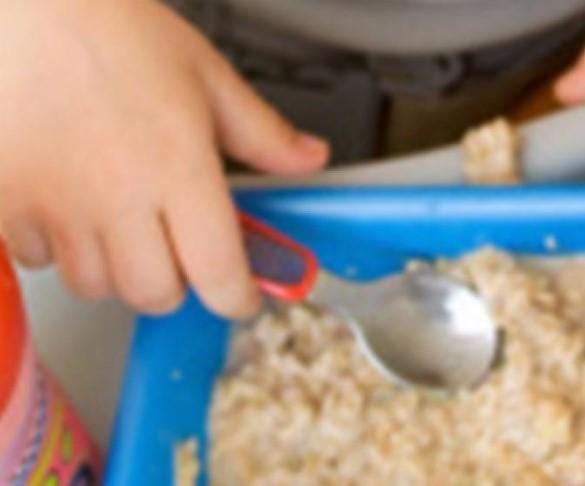

What's in This Article
- Your baby cries or is fussy.
- They put their fingers or first in their mouth, or suck on their fingers.
- Your little one opens their mouth wide when touched on his chin or lips and roots for a nipple.
- They squirm or move their arms and legs.
- Your baby moves, licks or smacks his lips or makes small sounds.
Motor skills
Your tot doesn’t just use their motor skills to move, they’re also important for trying new foods. Here’s what your little one is learning right now:
- Moving foods side-to-side in their mouth more often.
- Getting better at chewing.
- Licking their lips.
- Dipping foods.
- Using a few fingers to pick up food rather than their whole hand.
Self-feeding
While your cutie is on track to self-feed soon, they may still need your help to get there. If your little one seems like they’re ready to eat by themselves, these ideas should help:
- Start with 2 spoons—you hold one and they hold the other. They’ll learn by watching you eat with yours. They might try to grab your spoon, but go ahead and let them.
- Toddler-friendly utensils and plates are best. Spoons should have soft, big handles so it’s easy for little hands to grip. Plates should have curved sides so your little one can scoop food along the edges.
- Patience pays off. They’ll make a mess learning, but resist the urge to just feed them yourself (we know, it’s tempting).
- Start with foods that easily stay on spoons so your tot doesn’t get frustrated too often.
- Do not use disposable plastic spoons or forks—they break easily, can have sharp, scratchy edges and are a choking hazard.
If your tot is using their fingers to feed themselves:
- Try giving them developmentally appropriate, easy-to-pick up foods. Diced bananas, meat sticks and bite-sized snacks are all great choices.
- Avoid choking hazards like popcorn, whole grapes, hot dogs, nuts, gum or hard candy.
If your little one is learning how to use silverware or cups:
- Show them thick foods that won’t fall off the spoon—holding a spoon level might be hard for them at this stage.
- Try bite-sized foods they can eat with a fork, like soft, diced fruit.
- Use bowls that are shallow with large openings to offer easy access to finger feed.
The Importance of Chewing
We all chew our food, and your kiddo’s no different. But it’s really so much more than that. Chewing also:
- Stimulates jaw muscles to break down food.
- Makes swallowing easier because food is in smaller pieces.
- Mixes food with saliva before it gets to the stomach.
- Releases flavors.
Finding What They Like
Your tot likes certain foods after seeing the same ones over and over. The more you offer it, the better the chance is they’ll like it. It may seem like a losing battle when they ‘yuck’ at a food over and over again, but learning to enjoy different foods just takes a little time. Re-offering foods in a positive way is a good way to make progress, so keep trying. Encourage them by eating the food yourself while smiling and saying things like “yum”. Slowly but surely, they’ll get the message.
Remember, while you decide what’s on their plate, they decide what, and how much, they want. It can feel weird at first to leave food on their plate, but it will help them understand hunger and fullness later on.
The Right Food at the Right Time
New food is exciting, but introducing new textures, shapes and sizes of food should be based around your kiddo's individual needs. Watch your child for readiness cues and follow their skill development to offer the right textures when they're ready.
Give these Gerber Products a Taste!
-
CLP Certified

 Simply Pick-Ups™ Italian-Style Cheese & Chicken Ravioli (Pack of 8) 1 x 6oz Tray(Pack of 8) 1 x 6oz TrayToddler12+ monthsPreschooler24+ months
Simply Pick-Ups™ Italian-Style Cheese & Chicken Ravioli (Pack of 8) 1 x 6oz Tray(Pack of 8) 1 x 6oz TrayToddler12+ monthsPreschooler24+ monthsWholesome nutrition with none of the hassle! Made with no preservatives, artificial flavors, or synthetic colors, this ravioli is made with real cheese, chicken, and whole wheat flour.
$20.72 -
CLP Certified

 Simply Pick-Ups™ Italian-Style Cheese & Chicken Ravioli (Single) 1 x 6oz Tray(Single) 1 x 6oz TrayToddler12+ monthsPreschooler24+ months
Simply Pick-Ups™ Italian-Style Cheese & Chicken Ravioli (Single) 1 x 6oz Tray(Single) 1 x 6oz TrayToddler12+ monthsPreschooler24+ monthsWholesome nutrition with none of the hassle! Made with no preservatives, artificial flavors, or synthetic colors, this ravioli is made with real cheese, chicken, and whole wheat flour.
$2.59 -
CLP Certified

 Simply Pick-Ups™ Italian-Style Cheese & Chicken RavioliToddler12+ monthsPreschooler24+ months
Simply Pick-Ups™ Italian-Style Cheese & Chicken RavioliToddler12+ monthsPreschooler24+ monthsWholesome nutrition with none of the hassle! Made with no preservatives, artificial flavors, or synthetic colors, this ravioli is made with real cheese, chicken, and whole wheat flour.
$2.59 -
CLP Certified

 Simply Pick-Ups™ Chicken Parmesan Ravioli (Pack of 8) 1 x 4.5oz Tray(Pack of 8) 1 x 4.5oz TrayToddler12+ monthsPreschooler24+ months
Simply Pick-Ups™ Chicken Parmesan Ravioli (Pack of 8) 1 x 4.5oz Tray(Pack of 8) 1 x 4.5oz TrayToddler12+ monthsPreschooler24+ monthsWholesome nutrition with none of the hassle! Made with no preservatives, artificial flavors, or synthetic colors, this ravioli is made with real cheese, chicken, and whole wheat flour with 5g of protein per tray.
$20.721 -
CLP Certified
 Toddler PouchesGerber Fruit Puree & Yogurt Strawberry BananaToddler12+ monthsPreschooler24+ months
Toddler PouchesGerber Fruit Puree & Yogurt Strawberry BananaToddler12+ monthsPreschooler24+ monthsSee the goodness inside with our new clear window.
$1.69 -
CLP Certified

 Simply Pick-Ups™ Italian-Style Cheese & Chicken Ravioli (Pack of 8) 1 x 6oz Tray(Pack of 8) 1 x 6oz TrayToddler12+ monthsPreschooler24+ months
Simply Pick-Ups™ Italian-Style Cheese & Chicken Ravioli (Pack of 8) 1 x 6oz Tray(Pack of 8) 1 x 6oz TrayToddler12+ monthsPreschooler24+ monthsWholesome nutrition with none of the hassle! Made with no preservatives, artificial flavors, or synthetic colors, this ravioli is made with real cheese, chicken, and whole wheat flour.
$20.72 -
CLP Certified

 Simply Pick-Ups™ Italian-Style Cheese & Chicken Ravioli (Single) 1 x 6oz Tray(Single) 1 x 6oz TrayToddler12+ monthsPreschooler24+ months
Simply Pick-Ups™ Italian-Style Cheese & Chicken Ravioli (Single) 1 x 6oz Tray(Single) 1 x 6oz TrayToddler12+ monthsPreschooler24+ monthsWholesome nutrition with none of the hassle! Made with no preservatives, artificial flavors, or synthetic colors, this ravioli is made with real cheese, chicken, and whole wheat flour.
$2.59 -
CLP Certified

 Simply Pick-Ups™ Italian-Style Cheese & Chicken RavioliToddler12+ monthsPreschooler24+ months
Simply Pick-Ups™ Italian-Style Cheese & Chicken RavioliToddler12+ monthsPreschooler24+ monthsWholesome nutrition with none of the hassle! Made with no preservatives, artificial flavors, or synthetic colors, this ravioli is made with real cheese, chicken, and whole wheat flour.
$2.59 -
CLP Certified

 Simply Pick-Ups™ Chicken Parmesan Ravioli (Pack of 8) 1 x 4.5oz Tray(Pack of 8) 1 x 4.5oz TrayToddler12+ monthsPreschooler24+ months
Simply Pick-Ups™ Chicken Parmesan Ravioli (Pack of 8) 1 x 4.5oz Tray(Pack of 8) 1 x 4.5oz TrayToddler12+ monthsPreschooler24+ monthsWholesome nutrition with none of the hassle! Made with no preservatives, artificial flavors, or synthetic colors, this ravioli is made with real cheese, chicken, and whole wheat flour with 5g of protein per tray.
$20.721 -
CLP Certified
 Toddler PouchesGerber Fruit Puree & Yogurt Strawberry BananaToddler12+ monthsPreschooler24+ months
Toddler PouchesGerber Fruit Puree & Yogurt Strawberry BananaToddler12+ monthsPreschooler24+ monthsSee the goodness inside with our new clear window.
$1.69 -
CLP Certified

 Simply Pick-Ups™ Italian-Style Cheese & Chicken Ravioli (Pack of 8) 1 x 6oz Tray(Pack of 8) 1 x 6oz TrayToddler12+ monthsPreschooler24+ months
Simply Pick-Ups™ Italian-Style Cheese & Chicken Ravioli (Pack of 8) 1 x 6oz Tray(Pack of 8) 1 x 6oz TrayToddler12+ monthsPreschooler24+ monthsWholesome nutrition with none of the hassle! Made with no preservatives, artificial flavors, or synthetic colors, this ravioli is made with real cheese, chicken, and whole wheat flour.
$20.72 -
CLP Certified

 Simply Pick-Ups™ Italian-Style Cheese & Chicken Ravioli (Single) 1 x 6oz Tray(Single) 1 x 6oz TrayToddler12+ monthsPreschooler24+ months
Simply Pick-Ups™ Italian-Style Cheese & Chicken Ravioli (Single) 1 x 6oz Tray(Single) 1 x 6oz TrayToddler12+ monthsPreschooler24+ monthsWholesome nutrition with none of the hassle! Made with no preservatives, artificial flavors, or synthetic colors, this ravioli is made with real cheese, chicken, and whole wheat flour.
$2.59 -
CLP Certified

 Simply Pick-Ups™ Italian-Style Cheese & Chicken RavioliToddler12+ monthsPreschooler24+ months
Simply Pick-Ups™ Italian-Style Cheese & Chicken RavioliToddler12+ monthsPreschooler24+ monthsWholesome nutrition with none of the hassle! Made with no preservatives, artificial flavors, or synthetic colors, this ravioli is made with real cheese, chicken, and whole wheat flour.
$2.59 -
CLP Certified

 Simply Pick-Ups™ Chicken Parmesan Ravioli (Pack of 8) 1 x 4.5oz Tray(Pack of 8) 1 x 4.5oz TrayToddler12+ monthsPreschooler24+ months
Simply Pick-Ups™ Chicken Parmesan Ravioli (Pack of 8) 1 x 4.5oz Tray(Pack of 8) 1 x 4.5oz TrayToddler12+ monthsPreschooler24+ monthsWholesome nutrition with none of the hassle! Made with no preservatives, artificial flavors, or synthetic colors, this ravioli is made with real cheese, chicken, and whole wheat flour with 5g of protein per tray.
$20.721
| Food Groups | Serving Size Examples | Total Daily Goals: |
|---|---|---|
| Milk | ½ - ⅔ cup milk or yogurt 1 slice American cheese |
16 fl. oz. |
| Vegetables | ¼ cup soft, peeled and cooked, mashed or cut to bite-size pieces | ¾ cup |
| Fruits (Limit juice to 4 fl. oz. of 100% juice, only once a day) |
¼ cup soft peeled, mashed or chopped fruit; 4 fl. oz. 100% fruit juice | 1 cup |
| Meat/Beans | 1-3 tablespoons cooked; mashed or easy-to-chew chopped meat, beans or eggs | 1½ oz. |
| Grains (Choose whole grains whenever you can) |
¼ cup cereal, rice or pasta or ½ slice bread, ½ cup hot cereal | 2 oz. equivalent |
| Fats/Oils | ½-1 tablespoon dressing, cooking oil or soft margarine | 2 tablespoons |






